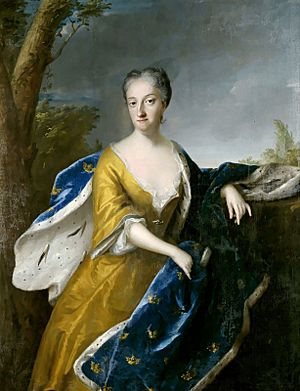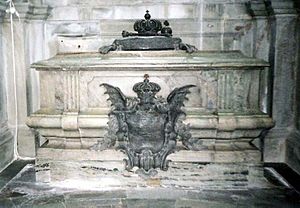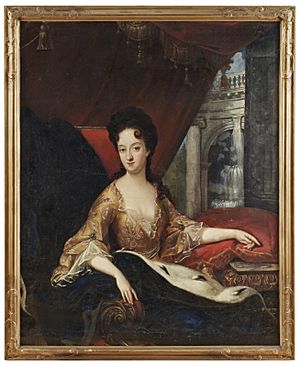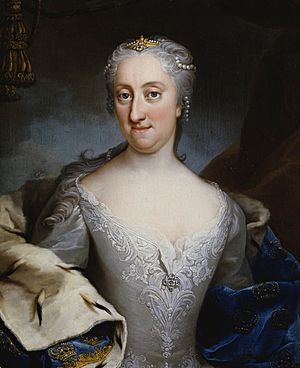Ulrika Eleonora of Sweden facts for kids
Quick facts for kids Ulrika Eleonora |
|
|---|---|

Portrait by Georg Desmarées
|
|
| Queen of Sweden | |
| Reign | 5 December 1718 – 29 February 1720 |
| Coronation | 17 March 1719 |
| Predecessor | Charles XII |
| Successor | Frederick I |
| Queen Consort of Sweden | |
| Tenure | 29 February 1720 – 24 November 1741 |
| Born | 23 January 1688 Stockholm Palace, Sweden |
| Died | 24 November 1741 (aged 53) Stockholm, Sweden |
| Burial | 1 December 1741 Riddarholmen Church |
| Spouse | |
| House | Palatinate-Zweibrücken |
| Father | Charles XI of Sweden |
| Mother | Ulrika Eleonora of Denmark |
| Religion | Lutheran |
Ulrika Eleonora (born January 23, 1688 – died November 24, 1741) was a Queen of Sweden. She ruled as queen from December 5, 1718, until February 29, 1720. She then gave up her throne for her husband, Frederick. After that, she was his queen consort (wife of the king) until she died.
Ulrika Eleonora was the youngest child of King Charles XI and Ulrika Eleonora of Denmark. She was named after her mother. When her brother, King Charles XII, died in 1718, she claimed the throne. Her older sister, Hedvig Sophia, had a son named Charles Frederick. He had a stronger claim to the throne because he was the next in line by birth order.
However, Ulrika Eleonora argued that she was the closest living relative to the late king. She also pointed to the example of Queen Christina, who had also ruled. The Swedish parliament, called the Riksdag, agreed to make her queen. But first, she had to promise to give up the absolute power that her father had held. In 1720, she gave up the throne to her husband, Frederick I.
Contents
Early Life and Becoming Regent
After her mother died in 1693, Ulrika Eleonora and her siblings were cared for by their grandmother, Hedwig Eleonora. Her grandmother seemed to prefer her older sister, Hedvig Sophia. Ulrika Eleonora was often overlooked compared to her more outgoing and talented sister. She was described as friendly, modest, and graceful. She had good posture and beautiful hands.
Ulrika Eleonora was a talented musician. She would play the clavier (an early piano) during court concerts while her sister sang. She often lived in the shadow of her famous brother, the king, and her popular sister.
From 1700, Ulrika Eleonora helped care for her grandmother, Hedwig Eleonora of Holstein-Gottorp. This was during her brother's long absence in the Great Northern War. Her older sister, Hedvig Sophia, was then seen as the most likely heir to the throne.
Marriage Plans and Royal Duties
Since her brother Charles XII was not married and had no children, Ulrika Eleonora was considered a possible future queen. This made her an attractive choice for marriage. Many marriage alliances were suggested for her. In 1710, she received a proposal from Prince Frederick of Hesse. Her trusted friend, Emerentia von Düben, helped with the discussions.
Her grandmother, Hedwig Eleonora, supported this marriage. She hoped Ulrika Eleonora would move to Hesse, which would increase the chances for her nephew, Charles of Holstein-Gottorp, to become king. The engagement was announced in 1714, and the wedding took place on March 24, 1715.
After her grandmother died in 1715, Ulrika Eleonora became the main figure at court. This was a happy time for her. She married Frederick I of Hesse-Kassel. She truly loved Frederick, but he had married her hoping to become king himself. He immediately started planning to have her named heir instead of her nephew. Two groups, the "Hesse Party" and the "Holstein Party", then competed for who would get the throne.
Ulrika Eleonora's position changed after her older sister, Hedvig Sophia, died in 1708. Ulrika Eleonora became the only adult royal family member in Sweden, besides her grandmother. In 1713, the government and her grandmother named her regent. This meant she would rule the country while the king was away. She became an important player in the struggle for power in a country without a clear heir.
The choice for the throne was now between Ulrika Eleonora and her nephew. People were very excited when she became regent. The Riksdag (parliament) wanted to end the absolute monarchy and get their own power back. As regent, she stayed informed about state matters. She urged her brother to return, warning him of problems if he did not. She was allowed to sign all state documents, except those sent directly to him. She saw herself only as her brother's helper and did not make her own suggestions.
Becoming Queen of Sweden
On December 5, 1718, Ulrika Eleonora learned that her brother, Charles XII, had died. She immediately declared herself the new monarch. The council was surprised but did not argue. She took control of the government and removed her brother's advisors from power. The "Hesse Party" helped Ulrika Eleonora become queen. They gained support from the Riksdag, who wanted to end the absolute monarchy and bring back parliamentary rule.
On December 15, 1718, she announced that she had inherited the throne. However, she promised not to keep the absolute power her father had. She agreed to bring back the older system of government. The war council wanted to get rid of absolute monarchy and the right to inherit the throne. But they were willing to accept her as an elected monarch.
Ulrika Eleonora had to agree to end absolute monarchy and the right to inherit the throne. This applied to both her and her nephew, Charles Frederick. After agreeing to sign the new constitution, she was elected queen on January 23, 1719. On February 19, she signed the Instrument of Government (1719). This agreement ensured the Estates (different groups in society) would support her and not her nephew.
She was crowned in Uppsala Cathedral on March 17, 1719. She made her official entrance into Stockholm as monarch on April 11 that year. During the ceremonies, she showed who her supporters were. When she met the nobility, she only let their representatives kiss her hand with her glove on. But other representatives were allowed to kiss her bare hand. Ulrika Eleonora never made the traditional journey through the country, called the Eriksgata, by herself. She did it with Frederick in 1722, after he became king.
Her short reign happened just before the end of the Great Northern War. In August 1719, during the Russian Pillage of 1719-1721, the Russian Fleet attacked Stockholm. Even with the attack, Ulrika Eleonora made her courtiers attend a planned reception. She acted as if there were no enemies nearby, which was seen as very brave.
Her closest friend and advisor was Emerentia von Düben (1669–1743). She had been Ulrika Eleonora's nurse and was made a lady-in-waiting. They had a very close relationship throughout their lives. Düben was her advisor, comfort, and support. People said she did not misuse her influence. They were described as being like sisters.
During her short time as queen, she gave noble titles to many families to gain their support. In 15 months, she made 181 people nobles. This was more than any other Swedish monarch. She had seven field marshals, while her brother usually had only three to five. Ulrika Eleonora actually preferred absolute monarchy. She had only agreed to the new constitution to secure the throne from her nephew. Her relationship with the council was not good. She often argued with the president of the Privy Council, Arvid Horn.
Ulrika Eleonora supported her husband's political goals. From the start, she wanted him to rule alongside her, like William III and Mary II in England. However, the Riksdag did not allow this. One reason was that co-ruling had been forbidden in Sweden since the 1400s. There was also opposition to the influence of Emerentia von Düben and her family in state matters.
Because Ulrika Eleonora found it hard to respect the new constitution and often discussed state affairs with her husband, the Riksdag was willing to replace her with Frederick as the only monarch if she gave up the throne. Frederick also supported this idea. On February 29, 1720, after being told again that she could not co-rule, Ulrika Eleonora gave up the throne to her husband. She did so on the condition that she would become queen again if he died before her. This condition meant she was still the heir to the Swedish throne until her death.
The Riksdag confirmed this change. She often said that giving up the throne was the biggest sacrifice of her life. Frederick became king on March 24, 1720.
Life as Queen Consort
When her husband became king, a period known as the Age of Liberty began. During this time, the monarchy lost most of its power to a parliamentary system. As queen consort (the king's wife), Ulrika Eleonora lived a more private life. She had married Frederick for love and was very loyal to him. At first, their relationship was happy. Before Frederick became king, he stayed in the role of her husband.
Ulrika Eleonora hoped to have children, but her marriage was childless. She had two miscarriages in 1715 and 1718. King Frederick suggested that his brother's family line should be next in line for the throne. Ulrika Eleonora supported this choice over her nephew, the Duke of Holstein-Gottorp.
Queen Ulrika Eleonora was very popular during her husband's reign. This was partly because she was the last member of the old royal family. It was also because of her strong religious faith. She knew that her popularity gave her power to influence decisions. When she shared her opinion, it was often followed. For example, in 1738, the queen showed she was unhappy about a certain person being chosen for a job. This led to public protests until that person met the queen and she assured him she would not interfere.
The relationship between Ulrika Eleonora and Frederick changed after he became king. People said that when she gave him the crown, she gave him his freedom.

Ulrika Eleonora served as regent (ruler in place of the king) twice. The first time was in 1731 when Frederick was away visiting Hesse. She ruled until he returned in the autumn. The second time was in 1738-1739 when Frederick was very ill and could not rule. She accepted this duty and managed state affairs until early 1739. During her second time as regent, she stopped the newly started Swedish theater. She refused to let them use their building, because some religious leaders were against the theater. However, the theater was allowed to open again the next year.
Ulrika Eleonora liked jewelry and music. She enjoyed dancing at court balls. She also hired German and French theater groups to perform. She was very religious and sometimes even stopped a parliamentary meeting to pray. At court events, she would ask young women about the Bible and reward them for correct answers. She was proud of her royal position. If she felt insulted, she would sometimes pretend to be sick and stay in her rooms. She relied a lot on Emerentia von Düben, but she also had other friends, like Hedvig Mörner and her childhood friend Anna Fleming.
Queen Ulrika Eleonora died from smallpox in 1741. There were rumors that she had been poisoned. But these rumors stopped when the signs of her illness were clearly seen during her public viewing. Since she was still the heir to the throne, her death led to a new crisis over who would rule next.
Images for kids
-
Ulrica Eleanor's sarcophagus in Riddarholm Church.
See also
 In Spanish: Ulrica Leonor de Suecia para niños
In Spanish: Ulrica Leonor de Suecia para niños









